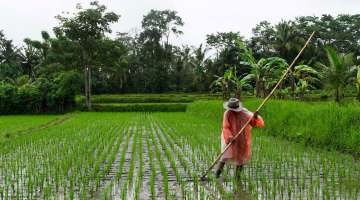POSTED Feb 20, 2023 - 08:43 AM
What is climate-smart agriculture and how will this help the Philippines?
Climate-smart agriculture isn’t a new concept for the Philippines. Here’s how this is being incorporated into our current farming practices
Climate-smart agriculture (CSA) has been on the Department of Agriculture’s (DA) agenda for years and recently, it entered the Department of Tourism’s line of vision as well. According to former DOT Undersecretary Benito Bengzon Jr., climate-smart farming is something the tourism arm of the government will be promoting in its farm tourism.
“I think climate-smart (agriculture) and green technology, the movement has started already and the fact that we are seeing a lot of resorts and hotels going green is an indication of deeper appreciation to protect the environment and in the long-term, for greater efficiency,” said Undersecretary Bengzon.
It’s common knowledge that agriculture, while vital for our survival, is also a significant source of greenhouse gases. CSA hopes to combat this by being part of the solution instead of the problem.
Understanding the relationship between agriculture and climate change
Climate change’s effects on agriculture have been tremendous. Droughts, heavy rainfall, and flooding have plagued cropland around the globe; sea levels have risen and river flow has reduced, drastically threatening aquaculture; and mass conversion of grassland and forest land to cropland has led to immense losses in soil carbon.
The economic impact of climate change on agriculture also cannot be ignored as developing countries absorb approximately 22 percent of the economic impact caused by climate change-induced hazards and disasters.
This is where CSA steps in to rectify the damages done by global warming and climate change.
According to the United Nations Food and Agriculture Organization, CSA seeks to increase agricultural productivity while decreasing its carbon footprint. The aim of the farming strategy is to accomplish climate change resilience in the agriculture sector to minimize its effects on the environment and the environment’s effects on agriculture.
However, the existing systems of agriculture pose a challenge as the sector contributes 19 to 29 percent of total greenhouse gas emissions. The sector will need to adapt its methods across the spectrum in order to strengthen its resilience against climate change.
At a glance, CSA is an approach buoyed by an eco-conscious mentality. Its specific goals include increasing productivity for food and nutrition security, which will in turn boost the economy of rural areas whose livelihoods rely on agriculture; enhancing resilience against droughts, shortened seasons, and erratic weather patterns; and reducing emissions for each kilo of food produced by rejecting deforestation and looking for ways to reduce the carbon in the atmosphere.
Local incorporation
Climate-smart farming has already been adopted in the Philippines, as encouraged by the DA. Some ways farmers have been doing this is through aquaponics, growing climate-resilient rice, adopting sloping agricultural land technology, harvesting rainwater for the dry season, and agro-reforestation.
The DA has attributed around P24 billion for climate change this 2022. The fund is set to be used for programs and activities that will push for climate resilience at the core.
Other more current climate-smart strategies are also now being implemented. According to the Food and Fertilizer Technology Center for the Asian and Pacific Region (FFTC), some of these strategies include utilizing a revolutionary guide map, which helps farmers identify “which crops are best grown for each area in the Philippines and where there are shallow water tables.” The guide map also notes fertilizers that may be needed to compensate for nutrients lacking in a particular area’s soil.
On the urban farming front, a smart farm has been developed at the Department of Science and Technology’s plant nursery in Quezon City. This project, which will serve as a space for new farming technology, is operated in coordination with the University of the Philippines Diliman and Los Baños. According to FFTC, vertical farming, micropropagation, cryopreservation, and hydroponics are among the techniques and technologies that are used.
The DA’s Agricultural Training Institute is also conducting climate-smart farming courses for farmers in Central Luzon.
Aside from these programs, the policy has also been put into place to protect and equip the sector against climate vulnerability. The DA launched the Adaptation and Mitigation Initiative in Agriculture (AMIA), among the programs of which include climate-smart agriculture and fisheries regulations that will require regulatory agencies to “redesign their services to take into consideration new technologies towards the promotion/development of climate-smart agriculture.”
With local tourism and hospitality preparing to incorporate CSA into their industry, increased awareness and support of the agricultural approach may foster change for the current state of climate change.
Original article: https://fnbreport.ph/10590/climate-change-smart-agriculture/
Text by Anri Ichimura
Additional text by Pauline Miranda
Read more

What is climate-smart agriculture and how will this help the Philippines?
Climate-smart agriculture isn’t a new concept for the Philippines. Here’s how this is being incorpor... Learn More

The essential role of seaweed in food security and sustainability
Coastal communities have turned to seaweed to sustain both ecosystems and local economies Learn More

How to make offices more sustainable
Creating a sustainable office space doesn’t have to be complicated. Here are some factors to conside... Learn More

The era of timber buildings has begun in PH
Timber is making a comeback in the construction industry because of its stable strength, durability,... Learn More
